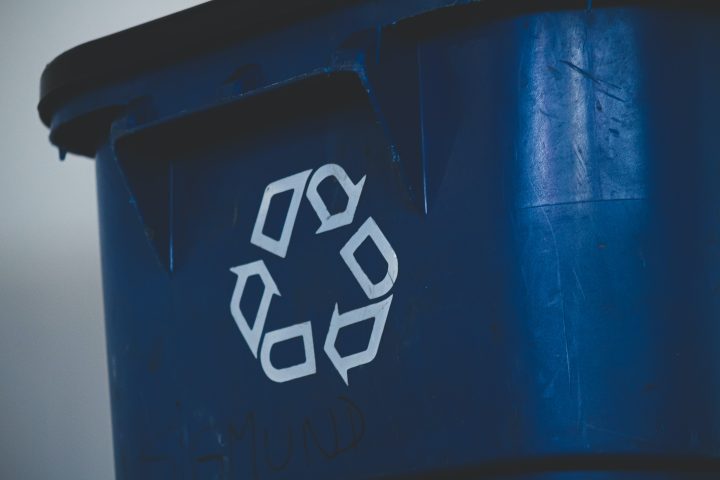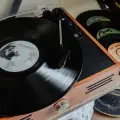Well, can you recycle vinyl records? What is the process like? Is it as difficult as they say? What other avenues can you go down instead of recycling? Are there any? And what do they look like?
All this and more today as we explore the various philosophical complications surrounding the recycling of vinyl records.

Well, Can You Recycle Vinyl Records?
Yes and no. Sure, you can recycle a vinyl record, but the process is incredibly complicated and requires specialized recycling facilities. These can be incredibly difficult to find and might not even exist in your area yet.
Recycling vinyl records is a tricky process precisely because of their chemical composition. In asking what vinyl records are made from, we find that the answer is in the name itself – PVC (Polyvinyl Chloride).
You might be more familiar with this in the acronym PVC, for it has a multitude of different uses. Many of the other things it is used for are far more widely accepted by companies that recycle things.
Old vinyl records, though, are made from much thicker layers of the PVC substance and thus are much more difficult to break down. To recycle vinyl records, you must be willing to deal with all of the toxic fumes emitted by the melting process.
Yes, indeed, old records release a whole load of poisonous gases that must be contained at all costs. Otherwise, they will escape into the atmosphere and damage the local wildlife or even the human population.
In this way, recycled vinyl can do more damage than simply chucking a record collection onto a waste heap. Are vinyl records recyclable? Sure, but the lengths you must go to do it properly are extraordinary.
Until record sales rise enough to make this a priority, it is unlikely that this kind of recycling facility is going to become more common. Indeed, digital music still reigns supreme, and rare albums can’t be found easily.
What Are Vinyl Records Made Of?
Though there is a far more comprehensive dive into this elsewhere on the website, we thought it best to get those not in the know up to speed.
Polyvinyl chloride is easily understood if we think of it as the combination of crude oil and chlorine at the root of what are vinyl records made of.
The name polyvinyl chloride might even be somewhat familiar, even if you have not necessarily heard it in this way before. For example, a lot of plumbing hardware, as well as other related things around the house, are made with the very same material, though it is more often referred to as PVC, which might sound more familiar to you.
Polyvinyl chloride in its natural state is more or less completely clear, which makes for some apposite opportunities for some experimental color combinations in how are vinyl records made. You might even have noticed that the most common color for vinyl records is still black, almost certainly for financial reasons, to save record producers and pressers money during the process by using a color that is likely cheaper than most other alternatives.
And yet, there are essentially infinite possibilities with regard to coloring, and you can find these experiments on releases past and present. I’ve noticed that it is common for reissues of older albums to feature colored discs remastered from the original tapes, where the music is pressed onto a color related to the cover of the album. I recently picked up a reissue copy of Commodo’s Procession, whose orange disc perfectly mirrored the splatterings of rusty orange all over the cover!
This can make for a great experience for vinyl collectors or can even, as the case may be, provide a way to abuse your fanbase even more than usual, as in the case of the industrial hip-hop group Death Grips. For example, they are known for having a more than masochistic relationship with their fanbase, a lighter example being that they print most of their records on clear vinyl, making it extremely difficult to play a specific song from around the middle of the disc.
But yes, the vinyl records that you know and love are rather bad for the environment, crude for it in a very big way – can we just learn to accept vinyl records for what they are? After all, record collectors are not going to let go of their vinyl collection anytime soon. These raw materials are here to stay.
Alternative to Vinyl Record Recycling
Seeing as there is unlikely to be an old record recycling facility near you anytime soon, here are some suggestions for how you can recycle those unwanted vinyl records and cassette tapes yourself:
Reselling
One of the premier recycling ideas that is going to profit you as well as the environment is selling your vinyl to others. This is especially applicable if the audio quality of your records is still in good shape.
In these cases, why not pass your records on so they can find a use in the arms and ears of a new listener?
Upcycling
You will have noticed that the material that vinyl is made from, PVC, is present in many products. It can exist either as a backing character or as their main ingredient. Being such an integral aspect of these products, you can turn your old vinyl into just about anything you can imagine.
One of the easier options is to use your old 7-inch vinyl record types as drinks coasters. You can also use 12-inch records as placemats at your dinner table. The sky really is the limit – the only bounds are those of your imagination. So go as wild as you like and never look back. If you can’t flog your records on to other collectors in garage sales and the like, why not make some wall art?
Using a Record Frame
Better yet, you can just hang up your records on the wall in a frame without any real effort on your part.
You really can’t go wrong with a record frame as a means to display records on a wall. It gets to the very heart of what an album cover is: art. Not that it should need a frame to hammer home just how much of a piece of art an album cover can be, but it certainly helps.
Most interestingly, such interior design gestures blur the line between different types of art, turning a piece of album art explicitly intended for use on an album cover and then placing it into a decidedly different context. Recontextualizing any art in this way tends to have rather interesting results, and this is especially the case when framing and reframing, and recontextualizing a piece of album art from one of your favorite LPs.
The freedom is all there, and it is yours for the seizing! You can place whichever album literally wherever you like, granted you don’t have a pesky landlord counting the number of pin holes in the wall at the end of your tenancy, of course (or maybe you are passed caring)! In this way, your favorite albums and favorite album art can be the focal point of a room’s design, directing the eyes and metaphysical ears of all guests who enter your domain.
Such record frames do not require you to be much of a whizz with a screwdriver or any other tool, for that matter. Simply grab a hammer and some nails and drive them in, and the rest is all set up for you. Insert your choice of record into the frame itself, even including the disc if you do not intend to listen to it in the near future, close the frame and then mount it on the screws in the wall, and away you go! Goodbye blank unexciting wall, hello interior design kingdom!
Final Tones
So, there you have it! Hopefully, your mind is feeling nourished and well-informed on the various issues surrounding the recycling of vinyl records. It sure is difficult to be conscientious of the wider world, but thankfully there are plenty of small changes you can make to do good for your planet.
FAQs Vinyl Record Recycling
How do I get rid of old vinyl records?
There is not currently a convenient way to properly recycle old vinyl records. Owing to the crude nature of the chemicals and materials used to fashion polyvinyl chloride into a vinyl record, they are immensely difficult to recycle into something else. Your best bet for repurposing your old vinyl records is likely either to sell them on to someone else who might want them or to upcycle them into something else and get creative.
Can old vinyl records be recycled?
Technically, yes, though the process is rather long and arduous. The chemicals from which polyvinyl records are fashioned are beleaguered with their own set of environmental concerns. Though there is a process by which old vinyl records can be recycled, it is currently incredibly expensive – owing to just how difficult it is to neutralize the harmful aspects of the base elements without causing further damage to the atmosphere and nearby wildlife – and thus, quite rare. Chances are, there are likely no specialized facilities near you that can cater to the recycling of old vinyl records.
Should I throw away vinyl records?
This depends on your own specific set of circumstances. Perhaps you are in need of some space in your living space and cannot spare any to keep your favorite records? Or maybe you are just moving on to other things in life and do not listen to records anymore? Either way, while it can be tempting to quickly and easily discard vinyl records in the trash, it is useful to remember just how long and arduous the recycling and decomposition process of these things is. Why not try upcycling your records instead, or better yet sell them on and earn some extra cash?
What can I do with a bunch of old records?
If you do not want to spend the time categorizing them and uploading them onto a site like, say, Discogs, then you can quickly and easily donate a whole bulk of records to your local charity store.





